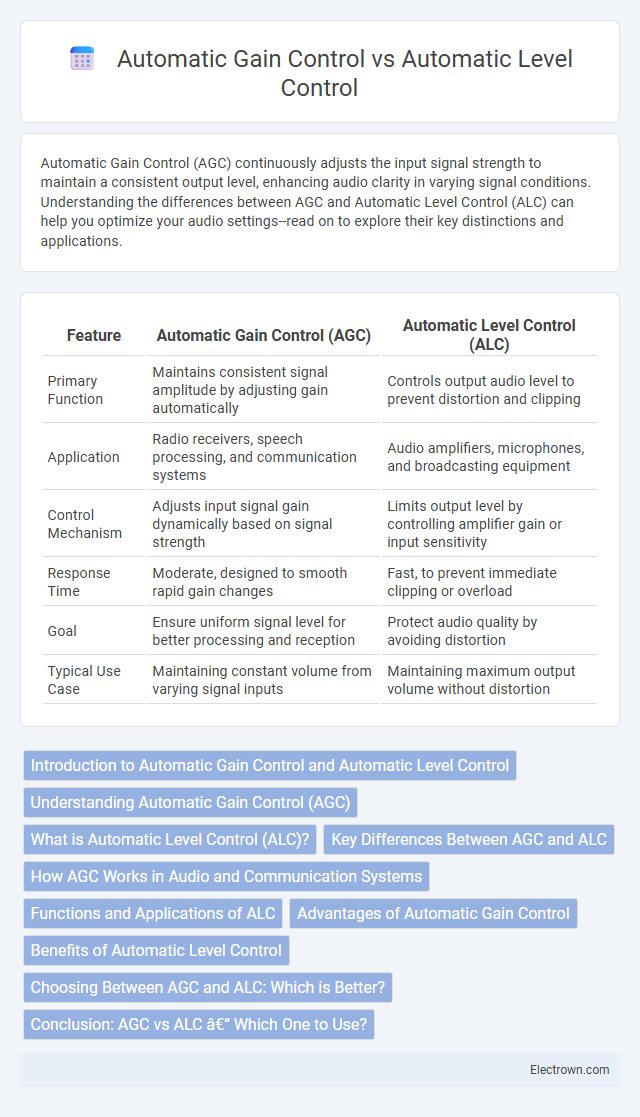Automatic Gain Control (AGC) continuously adjusts the input signal strength to maintain a consistent output level, enhancing audio clarity in varying signal conditions. Understanding the differences between AGC and Automatic Level Control (ALC) can help you optimize your audio settings--read on to explore their key distinctions and applications.
Table of Comparison
| Feature | Automatic Gain Control (AGC) | Automatic Level Control (ALC) |
|---|---|---|
| Primary Function | Maintains consistent signal amplitude by adjusting gain automatically | Controls output audio level to prevent distortion and clipping |
| Application | Radio receivers, speech processing, and communication systems | Audio amplifiers, microphones, and broadcasting equipment |
| Control Mechanism | Adjusts input signal gain dynamically based on signal strength | Limits output level by controlling amplifier gain or input sensitivity |
| Response Time | Moderate, designed to smooth rapid gain changes | Fast, to prevent immediate clipping or overload |
| Goal | Ensure uniform signal level for better processing and reception | Protect audio quality by avoiding distortion |
| Typical Use Case | Maintaining constant volume from varying signal inputs | Maintaining maximum output volume without distortion |
Introduction to Automatic Gain Control and Automatic Level Control
Automatic Gain Control (AGC) is a system designed to automatically adjust the gain of an audio or radio signal to maintain a consistent output level despite varying input signal strengths. Automatic Level Control (ALC) functions similarly by regulating the output level of audio signals to prevent distortion and maintain sound quality. Both AGC and ALC are essential in audio processing and communication systems for ensuring stable volume and clear signal transmission.
Understanding Automatic Gain Control (AGC)
Automatic Gain Control (AGC) is a technology designed to maintain consistent audio signal strength by automatically adjusting the gain based on the input volume level, preventing distortion and ensuring clarity. Unlike Automatic Level Control (ALC), which focuses more on maintaining a predetermined output level, AGC dynamically reacts to varying signal conditions in real-time. Your audio equipment benefits from AGC by providing balanced sound performance in environments with fluctuating sound intensities.
What is Automatic Level Control (ALC)?
Automatic Level Control (ALC) is a technology that stabilizes audio signal levels to prevent distortion and maintain consistent volume across varying input strengths. Unlike Automatic Gain Control (AGC), which dynamically adjusts gain to amplify weak signals, ALC focuses specifically on capping or limiting the maximum output level to avoid clipping and signal overload. Understanding ALC helps you ensure your audio devices produce clear, balanced sound without unexpected spikes in volume.
Key Differences Between AGC and ALC
Automatic Gain Control (AGC) continuously adjusts the gain of an audio signal to maintain a consistent output level despite varying input signal strengths, primarily used in communication systems to improve intelligibility. Automatic Level Control (ALC) stabilizes the amplitude of audio signals by limiting or compressing peaks to prevent distortion, commonly applied in recording and broadcasting environments. Key differences include AGC's dynamic gain adjustment over time for signal clarity, while ALC focuses on peak level regulation to protect equipment and maintain sound quality.
How AGC Works in Audio and Communication Systems
Automatic Gain Control (AGC) dynamically adjusts the amplitude of audio signals by increasing or decreasing gain to maintain consistent output levels despite varying input strengths. In communication systems, AGC continuously monitors signal strength and applies real-time gain adjustments to prevent distortion and optimize clarity, ensuring stable and clear reception. Your audio devices rely on AGC to deliver balanced sound without manual volume changes, improving user experience across different environments.
Functions and Applications of ALC
Automatic Level Control (ALC) maintains consistent audio signal amplitude by adjusting gain to prevent distortion, ensuring clear sound in transmission and recording systems. It is widely used in broadcasting, telecommunication devices, and audio processing to stabilize volume levels during varying input strengths. Unlike Automatic Gain Control (AGC), which primarily smooths out signal fluctuations, ALC focuses on keeping the output within a defined level to protect equipment and enhance audio quality.
Advantages of Automatic Gain Control
Automatic Gain Control (AGC) offers superior real-time signal optimization by maintaining consistent audio levels, enhancing clarity across varying input intensities. Your audio equipment benefits from AGC's ability to prevent distortion and clipping, ensuring high-quality sound in dynamic environments. AGC's adaptability makes it ideal for communications, broadcasting, and recording applications where stable output is crucial.
Benefits of Automatic Level Control
Automatic Level Control (ALC) ensures consistent audio output by maintaining steady signal levels, preventing distortion and listener fatigue. ALC optimizes dynamic range in real-time, enhancing clarity and overall sound quality across diverse audio environments. This technology reduces the need for manual adjustments, improving user convenience and system reliability.
Choosing Between AGC and ALC: Which is Better?
Choosing between Automatic Gain Control (AGC) and Automatic Level Control (ALC) depends on your specific audio processing needs; AGC dynamically adjusts the gain to maintain consistent signal amplitude, ideal for varying input levels, while ALC limits the audio output level to prevent distortion and clipping. AGC is better for applications requiring smooth volume adjustments without sudden changes, such as in broadcasting or communication devices, whereas ALC is preferred in environments focused on protecting downstream equipment from overload. Understanding your equipment's signal strength variability and desired output stability will help determine whether AGC or ALC provides the optimal audio control solution.
Conclusion: AGC vs ALC – Which One to Use?
Automatic Gain Control (AGC) dynamically adjusts the input signal gain to maintain consistent output levels, making it ideal for environments with varying signal strengths. Automatic Level Control (ALC) regulates the output signal to prevent distortion and protect equipment, ensuring signal integrity during transmission. Your choice depends on whether you need real-time gain adaptation (AGC) or stable output level protection (ALC) in your audio or communication system.
Automatic Gain Control vs Automatic Level Control Infographic

 electrown.com
electrown.com